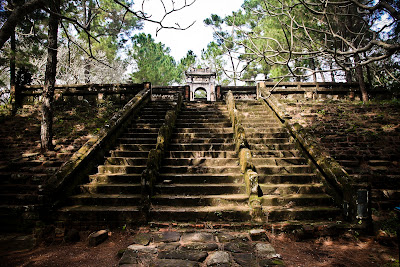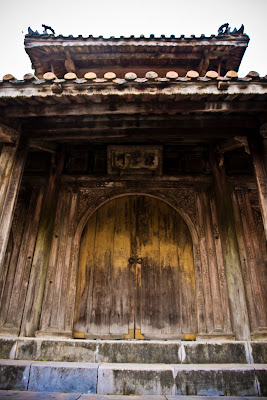(scroll down for English version)
Vietnam – Hue
La carretera
entre Hoi An y Hue te lleva a través de espectaculares montañas y a lo largo de
kilómetros de campos de arroz, que en esta época del año están llenos de agua.
Como de costumbre, me quedé dormida la mayor parte del viaje, pero me
despertaba por momentos para echar un vistazo a la espectacular vista.
Cuando llegamos
a Hue por la noche, nos acomodamos en nuestro hotel y fuimos a caminar para buscar
el Stop & Go Café, que nos recomendaron nuestros amigos franceses Sabrina y
Ludovic, a quienes conocimos en Chile hace varios meses. Ellos quedaron muy
felices con el tour en moto que habían hecho con Stop & Go Café. La cena no
estaba como para tirar cohetes, pero nos vimos los tours que ofrecen y
decidimos volver al día siguiente para confirmar.
A la mañana
siguiente, Christiane y Chris no se sentían bien por lo que Juan Pablo y yo nos
fuimos por nuestra cuenta después del desayuno. Nos detuvimos en el muelle de
preguntar acerca de los viajes en barco por el río, pero consideramos que sería
mejor esperar hasta mañana para ver si Christiane y Chris les interesaba unirse
a nosotros. Continuamos al Stop & Go Café para contratar el tour en moto y comprar
unos bocadillos para llevar con nosotros.
Nuestro guía
nos llevó primero a los alrededores de Hue, a través de los campos de arroz, hasta
un pequeño pueblo donde hay un viejo puente cubierto, el Puente Thanh Toan, a
menudo denominado simplemente como el puente japonés. Fue construido en los
1700s con fondos de una mujer de la localidad para mejorar el transporte y la
comunicación en el pueblo construido junto al canal. En la actualidad existe un
altar en el puente en su memoria. Nos bajamos de la moto y caminamos para tomar
algunas fotos.
Sentadas en el
puente había algunas viejecillas en sus tradicionales pijamas de seda con
sombreros de paja puntiagudos.
Nos subimos a la
moto y seguimos a nuestra guía a la tumba del emperador Tu Duc, quien disfruto
el reinado más largo de cualquier otro monarca durante la dinastía Nguyen de 1848
hasta 1883. En realidad, es todo un complejo con una casa de verano, un
estanque y varias tumbas de algunas de las esposas del emperador, así como un
mausoleo para él. Nuestro guía nos explicó que nadie sabe en qué parte del
terreno fue enterrado el emperador en realidad. Su cuerpo fue escondido con
tesoros y los presos que cavaron el túnel fueron asesinados. A pesar del
trágico final de aquellos que ayudaron a construir el lugar, es un lugar muy
hermoso y tranquilo.
De la tumba de
Tu Duc, nuestro guía nos llevó a la cima de la colina de Vong Canh donde había
una hermosa vista del río Perfume. También fue la ubicación de un puesto del
ejército durante la guerra de Estados Unidos.
Justo abajo de
la colina, hicimos una breve parada para ver a algunas mujeres haciendo
incienso y sombreros de paja.
A continuación en
nuestro recorrido en moto, fuimos a la Pagoda de Thien Mu que esta a la orilla del
río Perfume. Tiene siete pisos y es la pagoda más alta de Vietnam. La Pagoda de
Thien Mu fue el símbolo no oficial cuando Hue fue la capital imperial.
Cruzamos el río
y nos dirigimos hacia la Ciudadela y la Ciudad Prohibida, esta última modelada copiando
la Ciudad Prohibida de Pekín. Aunque ahora la mayoría esta en escombros, debido
a los bombardeos de la guerra de Estados Unidos, desde que fue nombrada
Patrimonio de la Humanidad por la UNESCO, se ha estado reconstruyendo
lentamente. La Ciudad Prohibida fue la residencia real del Imperio y contaba
con una serie de palacios, puertas y patios.
Nos encontramos
a Christiane y Chris. Ellos se sentían mejor y decidieron aventurarse a
turistear un poco. Estaban terminando su visita, así que decidimos reunirnos
más tarde para cenar.
Habíamos leído muy
buenas críticas del Café de Nina en Tripadvisor. Es un pequeño restaurante
familiar en una calle lateral que se ha vuelto muy popular. Tan popular, que
cuando llegamos todas las mesas estaban ocupadas. Nina pregunto a algunas
personas si les importaba compartir una mesa para poder darnos una mesa, pero
que debimos haber entendido la señal que estaban muy ocupados, porque tuvimos
que esperar, literalmente, dos horas por la comida. Llegó el punto en que
estábamos todos muy molestos y queríamos irnos, pero nos moríamos de hambre.
Después de algunos ruidos de nuestro estómago y algunos gestos, los platos
empezaron a salir uno por uno. Yo prácticamente había terminado con mi plato
cuando llego el de Juan Pablo. No hace falta decir, que el Café de Nina no
estuvo a la altura de nuestras expectativas.
Al día
siguiente, dimos un paseo en barco con Christiane y Chris. Tuvimos un comienzo poco
lento, y en el lugar donde Chris y yo fuimos a comprar bocadillos tardaron una
eternidad, así que solo tuvimos tiempo de visitar un templo y una pagoda a lo
largo del río. El viaje en barco era justo lo que necesitábamos todos, un tiempo
para relajarnos.
A nuestro
regreso, comimos algo y fuimos rápidamente a una panadería francesa, que
Sabrina nos había recomendado, y compramos unos pastelitos para el viaje nocturno
en autobús a Hanoi.
Vietnam – Hue
The road between Hoi An and Hue takes you through
some dramatic mountains and along miles of rice fields, which at this time of
the year are filled with water. As
usual, I fell asleep for most of the journey but woke up for a glimpse of the
striking view.
Upon arrival in Hue, in the evening, we settled
into our hotel and went for a walk to find the Stop & Go Café, recommended
to us by our French friends Sabrina and Ludovic, whom we’d met in Chile several
months ago. They raved about their
motorbike tour that they had booked at the Stop & Go Café. Dinner wasn’t much to rave about but we
checked out the tours they offered and decided we’d return the following day to
confirm.
The next morning, Christiane and Chris weren’t
feeling well so Juan Pablo and I headed out on our own after breakfast. We stopped by the pier to ask about
boat trips down the river but felt it would be better to wait until tomorrow to
see if Christiane and Chris might be up to join us. We continued on to the Stop & Go Café to book a
motorbike tour and order some sandwiches to take with us.
Our guide led us first into the countryside
around Hue, through the rice fields, to a small village where there is an old
covered bridge, the Thanh Toan Bridge, often referred to as just the Japanese
Bridge. It was constructed in the
1700s with funds from a local woman to improve transportation and communication
in the village that is built alongside the canal. There is now an altar on the bridge in her memory. We got off the bikes and walked around
to take some photos.
Sitting on the bridge were a few old women in
their traditional silk pajamas with pointy straw hats.
We got back on the motorbike and followed our
guide to the tomb of Emperor Tu Duc, who enjoyed the longest reign of any
monarch of the Nguyen dynasty from 1848-1883. It was actually an entire complex with a summer home, a
pond, and several tombs for some of the emperor’s wives, as well as a mausoleum
for him. Our guide explained
however, that no one knows where on the grounds the emperor was actually
buried. His body was hidden with
treasures and the prisoners who dug the tunnel to where he was buried were
killed. Despite the tragic end to
those who helped to build the place, it was a very beautiful and peaceful
place.
From the tomb of Tu Duc, our guide took us to the
top of Vong Canh Hill from where there was a lovely view of the Perfume
River. It was also the location of
an army post during the American War.
Just down the hill, we made a quick stop to see
some women making incense and straw hats.

Next on our motorbike tour was the Thien Mu
Pagoda that sits at the edge of the Perfume River. It has seven stories and is the tallest pagoda in
Vietnam. Hue was once the imperial
capital and the Thien Mu Pagoda its unofficial symbol.
We crossed the river and rode towards the Citadel
and the Forbidden City, modeled after the Forbidden City in Beijing. Although now mostly rubble, due to
bombings in the American War, that is painstakingly being rebuilt since it was
named a UNESCO World Heritage Site, the Forbidden City was once the home of the
Imperial Empire with a network of palaces, gates, and courtyards.
We ran into Christiane and Chris. They were feeling better and decided to
venture out for a little bit of tourism.
They were just finishing their visit so we agreed to meet them later for
dinner.
We’d read glowing reviews for Nina’s Café on Trip
Advisor. It’s a small family
restaurant on a side street that has become quite popular. So popular, in fact, that when we
arrived, all the tables were full.
Nina asked a few people to share a table so we could sit down, but we should
have taken the cue that they were too busy because we ended up waiting
literally about two hours for our meal.
It got to the point where we were all quite uncomfortable and wanted to
leave but we were starving. After
some stomach rumbling and facial grimaces, the dishes started coming out one by
one. I was practically finished by
the time Juan Pablo got his dish.
Needless to say, Nina’s Café didn’t live up to our expectations.
The following day, we took a boat ride with
Christiane and Chris. We had a bit
of a slow start, and the place where Chris and I went to buy sandwiches took forever,
so we only had time to visit one temple and the pagoda along the river. The boat ride was just what we all
needed, some time to relax.
Upon our return, we had something to eat and then
made a quick trip to a French bakery Sabrina had told us about to buy some
pastries for the overnight bus ride to Hanoi.




























































No comments:
Post a Comment